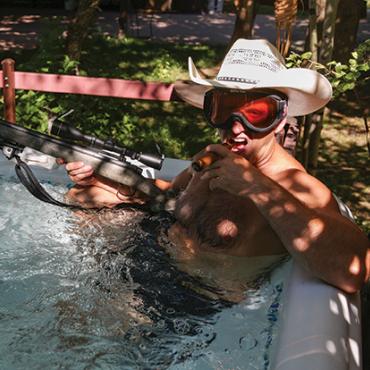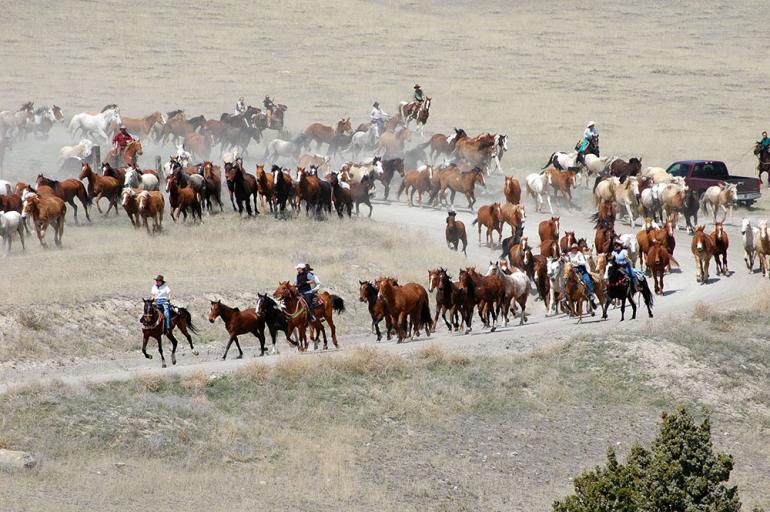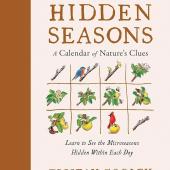Spring Roundup
From my blocking position atop a rock outcropping, I scan the broad, sage-covered slope below. There's movement to my left. Sliding along like phantoms, a small group of horses has veered out of a narrow gully and wheeled back upslope. If they make the ridge, they'll be gone, lost amid the shaded draws and deep ravines that tumble westward for miles. I turn my horse, Frit, giving him a swift kick and a sharp YAH! to get him moving. It takes some prodding—Frit is lethargic by nature, and hasn't worked all winter—but soon we're racing across the slope, angling toward an intercept point just below the ridgeline. Frit's massive hooves beat the earth in a steady cacophony of thumps and ricocheting divots. Successive kicks ratchet his speed still higher. It'll be close, but if Frit keeps this pace, we should be able to head off the group just below the crest, and get them turned back down the hill.
Suddenly, a fast-moving shape appears to my left. It's Kail Mantle, careering through the sage on a dark horse. Kail is one of the owners of the 250 head we're rounding up today, and he's not about to let this little group of equine infidels create another half-day's work for him and his men. He drives toward them at an astounding clip, passing me in a blur of Carhartts, leather, and fur. His mount, a young Arab gelding named Al, glides across the slope like a racehorse: even-keeled, fluid, muscles rippling with every stride. I give Frit my heels again, and again. He's holding back, the lazy cuss, but even on his best day he couldn't catch that Arab. My moment of glory is shot. I let Frit slow to a walk and head back down the hill. Time to meander again, across the shallow draws and open slopes to the north, where the bulk of the herd has converged.
This is Spring Roundup, an annual mid-April event held throughout the West, and for Kail & Renee Mantle, it's just another day at the office. After a long Montana winter, it's time to gather the horses from their wintering grounds, truck them back to the ranch, tend their wounds and ailments, and get them in shape for the coming season. As the owners of Montana Horses, a horse-leasing outfit in Three Forks, Kail and Renee supply trail mounts to many of the area's guest ranches. They also lease horses to outfitters and private hunters during the autumn months. As Montana's guest ranch and hunting industries have skyrocketed, so has Montana Horses. "Eight years ago," remembers Renee, "we started with 14 horses. Now we've got over 300."
Renee is a genuine cowgirl, with the magnetic inner security that comes from hard work and a life lived close to the land. With her warm smile and gentle demeanor, she tells me about their routine: up before dawn, saddling the horses, rounding up and feeding stock (in addition to the horses, they keep 200 head of cattle), mending fences, trailering horses to clients... the list goes on. And it's the same daily roster, week in, week out. "It's hard work," she admits, "this way of life. But it's a good one." Ranch life isn't for everyone, she allows, and a hard Montana winter can certainly test her resolve. But city life appeals to her and Kail about as much as tofu would to a wolverine. Their place is here. They live to be outside, in the open country.
And so do the horses. After roaming the hills all winter, they look a bit thin—but they're strong, healthy, and full of life. Watching them lope across the hillside, Kail and Renee are reminded of how fortunate they are to have this winter pasture. At 7,000 acres, it dwarfs most other wintering grounds, and can almost support their entire herd. "With all the subdivisions going in," Kail explains,"we'll get 20 acres here, 20 there." But out here, they can turn upwards of 300 head loose and pretty much forget about them until spring. An intractable utilitarian, Kail extols the practical advantages of the pasture: a lightened wintertime workload, a huge reduction in feed costs. Renee digs a little deeper. She scans the rugged hills, sage-flecked and billowing westward in fold after fold of wild, unbroken country. "For a few months a year," she says, "they get to be horses."
By late morning, the clouds are high overhead, and a brisk wind blows in steadily from the west. The only color on this gray April day comes from the lichen-covered rocks that speckle the hillside. Frit and I amble toward the other riders, and we gather on a small knoll near the far side of the pasture. After a quick briefing from Kail, we fan out, dropping into a broad, gently sloping field. To the left is the west fenceline; far down to the right, the corral. A long bluff rises steeply in front of us, its broad surface tapering down into the field a mile below. The herd is clustered on the upper corner of the bluff, furtive and anxious. With the exception of an old rancher who lives at the bottom of the canyon, they haven't seen a human for months. Now there are eight of us on horseback, coming right toward them. They bob their heads and whinny, darting back and forth across the bluff.
Renee takes off across the field, hugging the fenceline and slipping in behind the herd at the top of the bluff. When the rest of us are in position, Kail gives her the signal. She whoops and swings her crop around, charging the herd. Confused at first, and not a little alarmed by the screaming human rushing toward them, the horses scamper around erratically. Eventually a few of them turn downhill, and the others begin to follow. Renee zigzags across the bluff as she rides, discouraging upward escape.
Down in the field, we all turn and parallel the herd, keeping an eye on the only remaining escape routes: a few steep, washed-out ravines that spill down the face of the bluff. But none of the horses try to break away. They're gaining speed now, running blindly, their individual identities merging into one continuous rush of equine mass. The intensity of the moment, the frenetic fever of collective motion—the herd instinct takes over, and they charge madly down the slope.
Frit feels the herd's energy. His muscular frame tightening beneath me, he lurches forward, hooves digging into the dry, cracked earth. Within seconds he's at a full sprint. All I can do is dig my feet into the stirrups and hang on. A narrow washout appears before us; before I can veer Frit away, we're over it. I look back, amazed at the 15-foot leap."Holy shit, Frit!" I yell to my half-crazed steed. "This is more like it!" Nose down, Frit's head pulses forward and back in harmony with his long, powerful stride. The ground rushes by, the sagebrush a bluish-gray blur. If I fall off now, I'm sure to break a bone or crack open my skull. I lean forward and white-knuckle the horn.
As we near the end of the field, where the leading edge of the bluff spills in, I wrench hard on Frit's reigns. He fights me for a bit, then veers off and comes to a stop near the entrance to the corral. The other riders pull up beside me. We all turn and stare as the herd roars down the final stretch, the ground reverberating under their deafening hoofbeats. Dust flies up everywhere. One of the riders leans over and shouts above the din: "A couple hundred horses chargin' along full-bore, manes blowin' in the wind, with a long-haired cowgirl just a-whoopin' along behind 'em—now that, boys, is somethin' to see."
Indeed it is. And maybe this is one of the reasons that so many people—Kail and Renee, the cowboys we rode with today, the rancher at the bottom of the canyon, and countless others across the West—happily decline the seductive comforts of city living, choosing instead a less insulated existence. A life lived primarily outdoors, where there's no shortage of discomfort, inconvenience, and toil—but a life that gleans from that very toil a deeper understanding of the land and our relationship to it. One that finds greater rewards in the adrenaline rush of a charging herd than the availability of fresh seafood. And one that offers days like today, when no amount of work can take the smile off your face.














